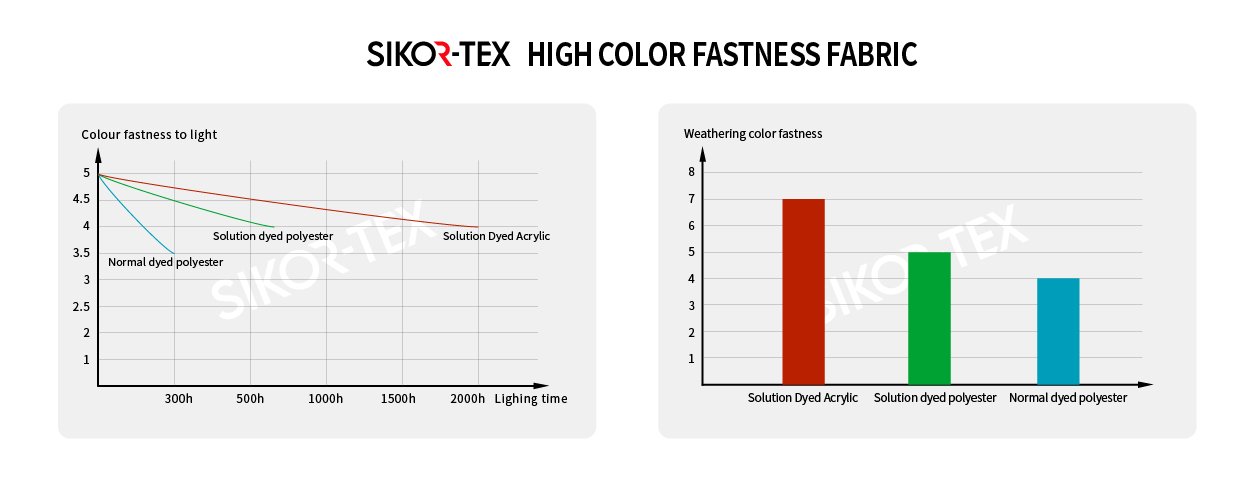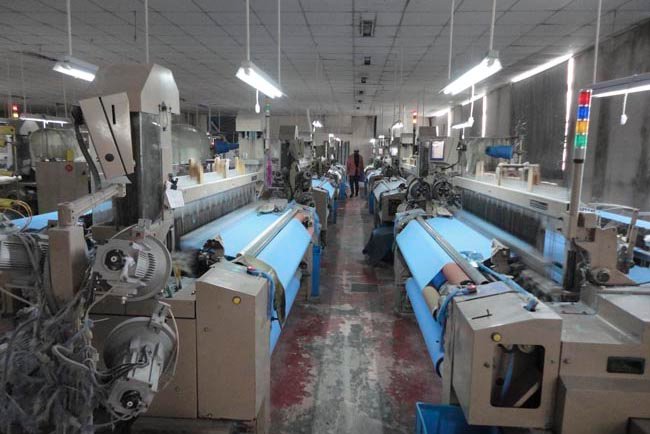
الأقمشة المصبوغة بالمحلول (المعروفة أيضًا باسم الأقمشة المصبوغة بالمخدر): المنسوجات المستدامة
لقد جذبت عملية الصبغ بالمحلول (المعروفة أيضًا باسم الصبغ المخدر) الكثير من الاهتمام في تطوير صناعة النسيج.
عملية الصبغ بالمحلول:
تستخدم الأقمشة المصبوغة بالمحلول خيوطًا مصبوغة بالمحلول. أثناء عملية الغزل، تُضاف أصباغ الماسترباتش إلى مصهور البوليمر لتشريب الألياف بالكامل بالأصباغ، ثم يتم غزلها وتبريدها وتمديدها لتشكيل حزم ألياف ملونة.
مميزات الأقمشة المصبوغة بالمحلول:
Excellent color fastness: SIKOR-TEX's solution-dyed fabrics use a special solution polyester spinning process, and their light fastness reaches AATCC16-3, UV500 hours, level 5 standard. When used for outdoor products such as outdoor المظلات, they can maintain bright and stable colors for a long time in different outdoor environments, effectively avoiding the problem of dye batch differences in traditional piece dyeing processes.

الأقمشة المصبوغة بالمحلول تتمتع بثبات فائق في اللون
تتميز أقمشة الصباغة بالمحلول بثبات قوي للألوان في مواجهة أشعة الشمس، كما تتميز بمقاومة ممتازة لبهتان الأشعة فوق البنفسجية وتغير اللون. على سبيل المثال، لا تزال أقمشة الإعلانات الخارجية قادرة على الحفاظ على الألوان الزاهية تحت أشعة الشمس الطويلة الأمد.
الأقمشة المصبوغة بالمحلول لها لون موحد للغاية
لا يوجد فرق تقريبًا في اللون بين الدفعات المختلفة، وهو مناسب جدًا لإنتاج المنسوجات القياسية على نطاق واسع مثل أغطية الفنادق ومفارش طاولات المطاعم.
تتمتع الأقمشة المصبوغة بالمحلول بقدرة تحمل قوية
يمكن لأقمشة الصباغة بالمحلول أن تتحمل عمليات غسل متعددة وتتمتع بثبات ممتاز للألوان الحمضية والقلوية، ويمكنها التكيف مع بيئات الاستخدام الخاصة مثل ملابس العمل في المستشفيات وملابس الحماية المخبرية.
تتمتع الأقمشة المصبوغة بالمحلول بمقاومة ممتازة للطقس
يمكن استخدامها بشكل طبيعي في ظل الظروف المناخية القاسية مثل درجات الحرارة المرتفعة والحرارة، والبرد الشديد والتجمد، والرطوبة والمطر، والجفاف والرياح، ولها مجموعة واسعة من التطبيقات.
الأقمشة المصبوغة بالمحلول صديقة للبيئة وتوفر المياه
نظرًا لأن عملية الصباغة لا تستخدم الماء، فإنها تقلل بشكل كبير من استهلاك موارد المياه وتقلل من التلوث البيئي. إنها نموذج نموذجي للمنسوجات المستدامة.



التحديات الحالية في صناعة النسيج
إن عمليات الصباغة التقليدية غير فعّالة، حيث يتم فقدان حوالي 300 ألف طن من الأصباغ في مياه الصرف الصحي كل عام، مما يؤدي إلى تلوث البيئة المائية بشكل خطير. وفي الوقت نفسه، وبسبب نطاقها الواسع وعملياتها العديدة، تعد صناعة النسيج واحدة من المصادر الرئيسية لانبعاثات الغازات المسببة للاحتباس الحراري.
أهمية العملية
تتمتع عمليات صباغة المنشطات والصباغة بالمحلول بمزايا واضحة من حيث حماية البيئة وأداء اللون. فهي لا تلبي احتياجات المستهلكين المعاصرين للمنسوجات عالية الجودة والصديقة للبيئة فحسب، بل تساعد أيضًا شركات المنسوجات على التعامل مع ضغوط اللوائح البيئية والمنافسة في السوق. وفي سياق التقدم التكنولوجي المستمر، فإنها ستقود بالتأكيد صناعة المنسوجات نحو مستقبل أكثر خضرة واستدامة، مما يجلب تغييرات جديدة في جودة المنتجات النسيجية وصورتها البيئية.

تعرف على المزيد حول الأقمشة الصديقة للبيئة
الأقمشة القابلة لإعادة التدوير
أقمشة النايلون القابلة لإعادة التدوير
أقمشة الأكريليك المصبوغة بالمحلول

Suzhou Sikor Industry Co.,Ltd هي مؤسسة مبتكرة يقع مقرها الرئيسي في سوتشو، الصين، وتتمتع بخبرة واسعة في إنتاج أقمشة الألياف الكيميائية المنسوجة عالية الأداء.
وتشمل الأقمشة الرئيسية لدينا أقمشة خفيفة الوزن, أقمشة ريبستوب, مستدامة وقابلة للتحلل المنسوجات والأقمشة المنسوجة والأقمشة الوظيفية، وخاصة الأقمشة الوظيفية، أقمشة مقاومة للماء وقابلة للتنفس، أقمشة قابلة للحام، أقمشة ذات 3 طبقات أقمشة, مضاد للجراثيم مقاومة للرائحة ومتينة نسيج كوردورا.
تم تصميم هذه الأقمشة لتوفير حماية خاصة ومناسبة لباس غير رسمي, ملابس رياضية في الهواء الطلق, ملابس العمل. تطبيقات مختلفة بما في ذلك الحقائب والخيام، لوازم التخييم و صناعي الاستخدامات.








